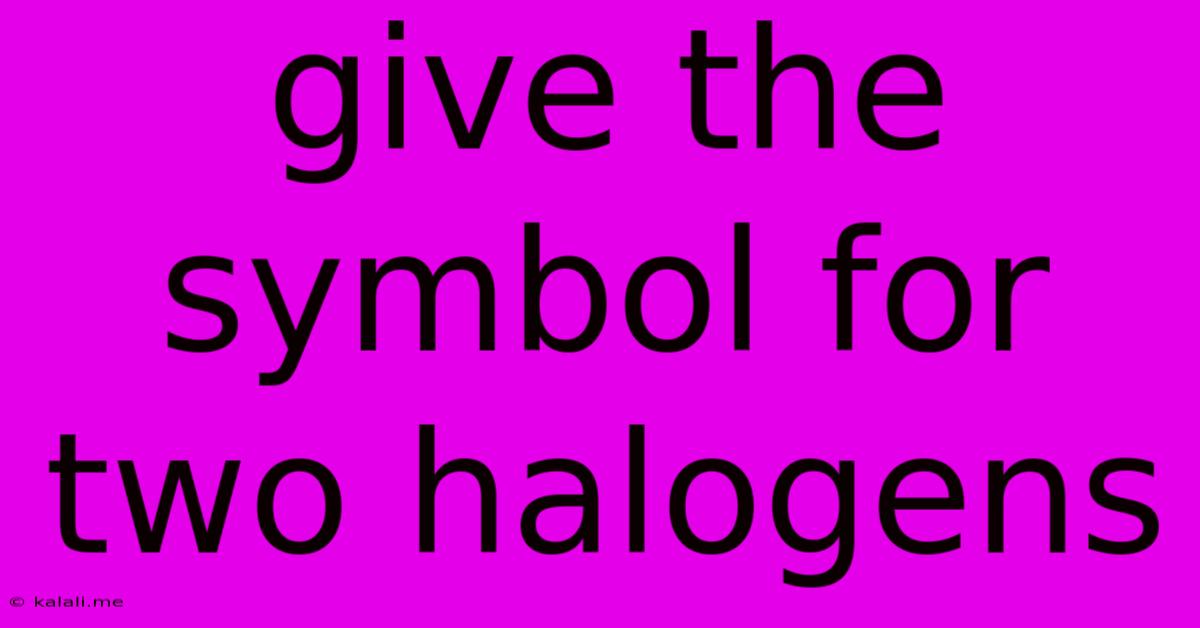Give The Symbol For Two Halogens
Kalali
May 09, 2025 · 3 min read

Table of Contents
Give the Symbol for Two Halogens: A Deep Dive into Group 17
This article will explore the fascinating world of halogens, specifically answering the question: "Give the symbol for two halogens." We'll go beyond simply providing the symbols, delving into their properties, reactivity, and real-world applications. Understanding halogens is crucial for anyone interested in chemistry, from students to seasoned professionals.
What are Halogens?
Halogens are a group of non-metal elements found in Group 17 (or VIIA) of the periodic table. They're known for their high reactivity, readily forming ionic compounds (salts) with metals. This high reactivity stems from their electron configuration—they only need one more electron to achieve a stable octet, making them powerful oxidizing agents.
Two Examples and Their Symbols:
Two of the most common halogens are:
-
Chlorine (Cl): Chlorine is a yellowish-green gas at room temperature. It's widely used in water purification and as a component in many industrial processes. Its symbol is Cl.
-
Fluorine (F): Fluorine is a pale yellow gas, and the most reactive of all the elements. It's crucial in dental health (fluoride in toothpaste) and has applications in the production of various fluorocarbons. Its symbol is F.
Beyond Chlorine and Fluorine: Exploring the Halogen Family
While chlorine and fluorine are frequently discussed, the halogen family includes other important elements:
-
Bromine (Br): A reddish-brown liquid at room temperature, bromine is used in various industrial applications and in the production of certain flame retardants.
-
Iodine (I): A dark-grey solid that sublimes readily (turns directly into a gas), iodine is essential for thyroid function in humans and is used in antiseptic solutions.
-
Astatine (At): Astatine is a radioactive element, extremely rare and unstable. Due to its radioactivity, its applications are limited.
Key Properties of Halogens:
All halogens share common properties, including:
- High electronegativity: They strongly attract electrons in chemical bonds.
- Seven valence electrons: This characteristic drives their high reactivity.
- Formation of diatomic molecules: They exist as diatomic molecules (e.g., Cl₂, F₂) in their elemental form.
- Oxidizing agents: They readily accept electrons, causing oxidation in other substances.
- Varied physical states: They can exist as gases (fluorine, chlorine), liquids (bromine), and solids (iodine, astatine) at room temperature, reflecting their increasing atomic size down the group.
Halogens in Everyday Life:
Halogens are integral to our daily lives:
- Water purification: Chlorine is used to disinfect drinking water.
- Dental health: Fluoride helps prevent tooth decay.
- Medicine: Iodine is used as an antiseptic and is crucial for thyroid function.
- Industry: Halogens are used in the production of many plastics, refrigerants, and other chemicals.
Conclusion:
In conclusion, the symbols for two common halogens are Cl (chlorine) and F (fluorine). However, understanding the broader context of the halogen group—their properties, reactivity, and applications—provides a much richer understanding of their importance in chemistry and daily life. The information provided here offers a solid foundation for further exploration of this fascinating group of elements. Remember to always handle halogens with caution due to their potential toxicity and reactivity.
Latest Posts
Related Post
Thank you for visiting our website which covers about Give The Symbol For Two Halogens . We hope the information provided has been useful to you. Feel free to contact us if you have any questions or need further assistance. See you next time and don't miss to bookmark.